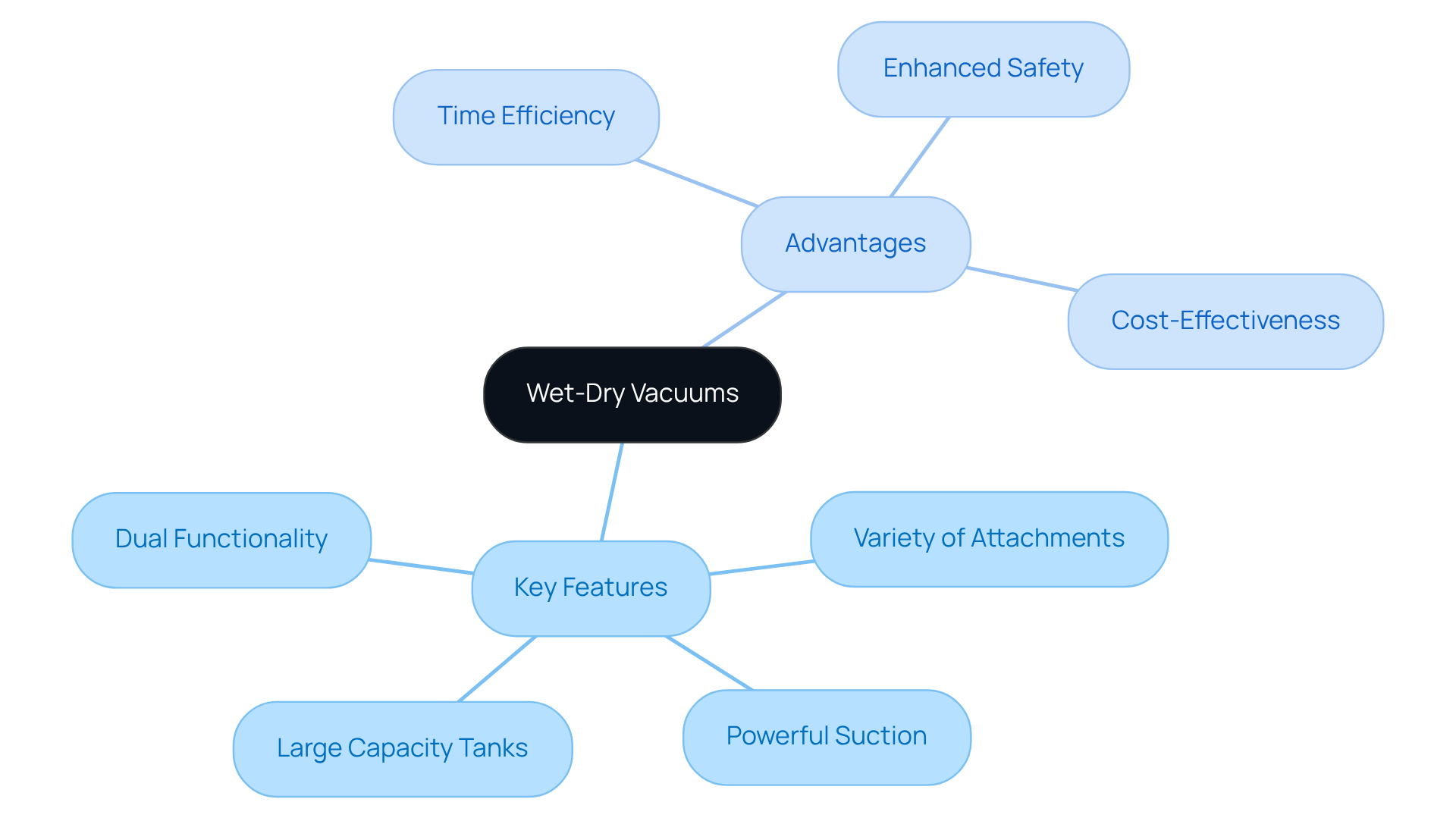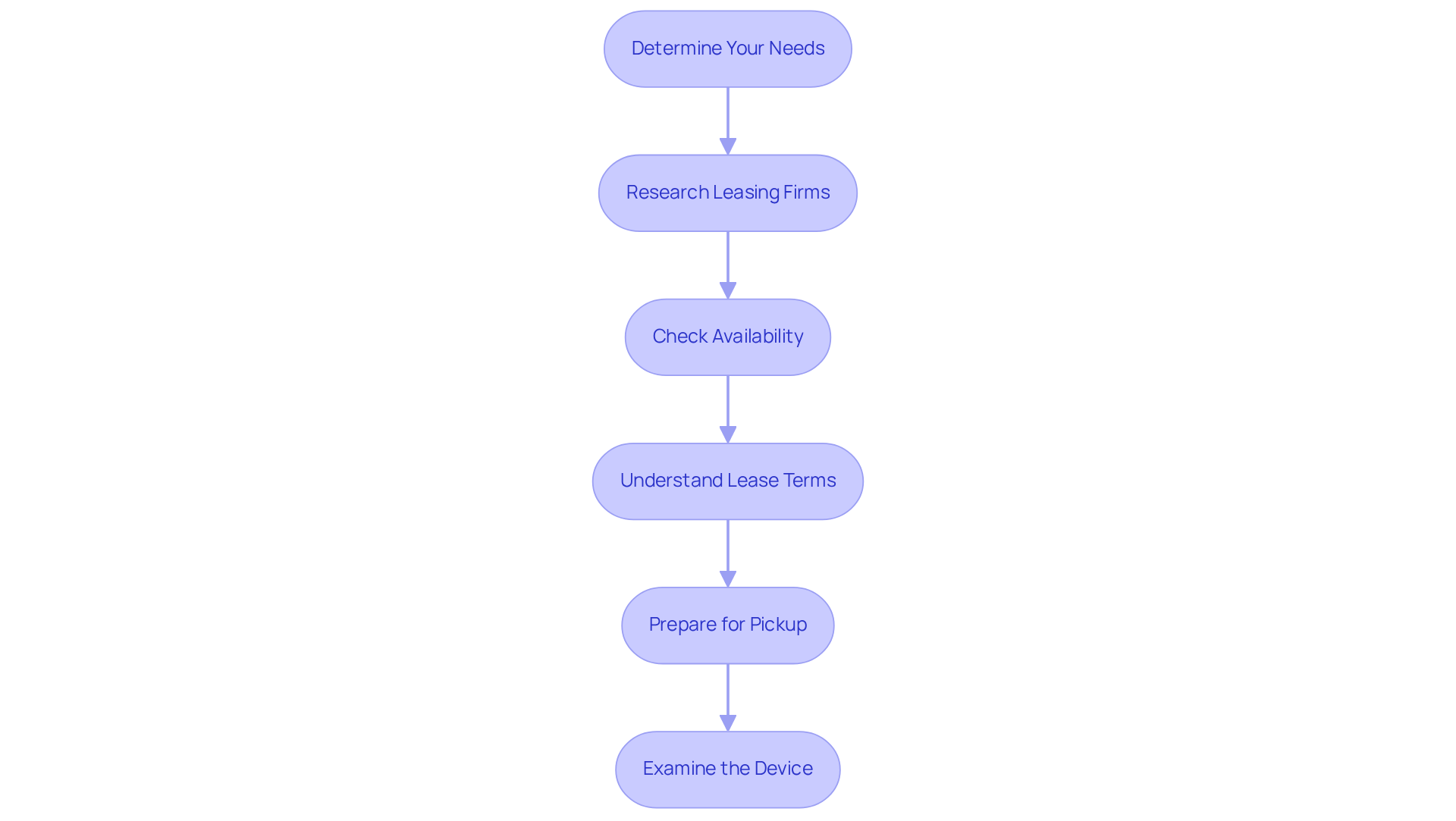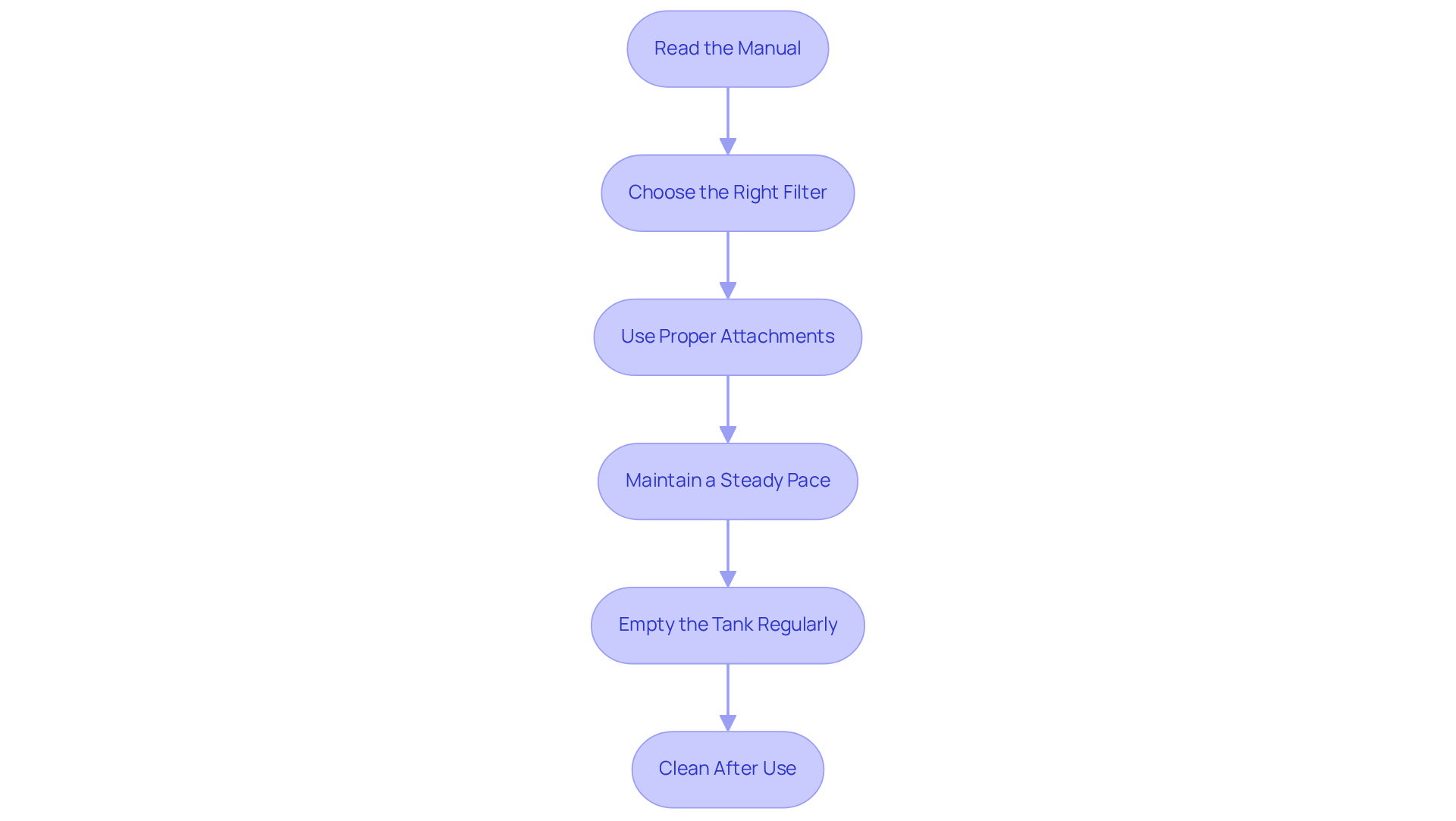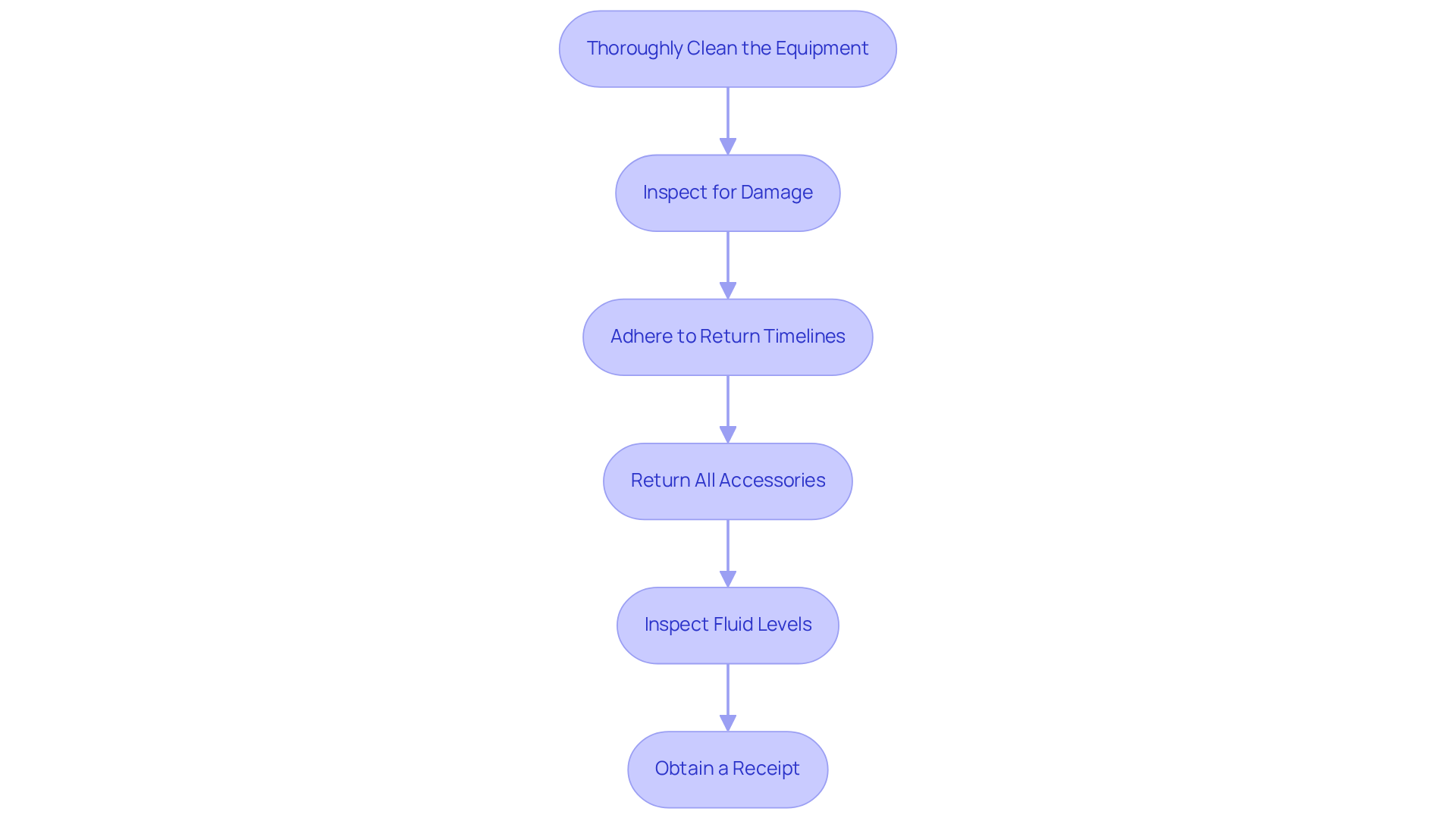Overview
This article serves as a comprehensive guide for managers seeking to effectively rent and utilize wet-dry vacuums. It underscores the significance of understanding the features of these vacuums, the rental process, and best practices for their usage and return. By following detailed steps for assessing needs, selecting rental firms, and ensuring proper maintenance and cleanliness, managers can enhance efficiency and safety in construction environments.
Understanding the available services is crucial. Wet-dry vacuums offer versatility, enabling managers to tackle various cleanup challenges. Their robust design ensures reliability, making them an essential tool in construction and maintenance operations. Furthermore, selecting the right rental firm can significantly impact the quality of service received, allowing for a seamless experience that meets specific project demands.
In addition, proper maintenance and cleanliness of rented equipment cannot be overstated. Regular upkeep not only prolongs the life of the vacuum but also ensures optimal performance. By adhering to best practices, managers can prevent potential issues that may arise during usage, ultimately leading to safer work environments.
To encourage immediate engagement, consider reaching out to local rental firms today. Explore the benefits of renting high-quality wet-dry vacuums and discover how they can enhance your operational efficiency. Take action now to ensure your projects are equipped with the best tools available.
Key Highlights:
- Wet-dry vacuums are essential in construction for managing both liquid and solid waste.
- Key features include dual functionality, powerful suction, large capacity tanks, and versatile attachments.
- Benefits include time efficiency, enhanced safety by reducing slip hazards, and cost-effectiveness in renting versus buying.
- The U.S. market for wet-dry vacuums is projected to grow at a rate of 4.7% annually through 2033.
- The rental process involves assessing needs, researching firms, checking availability, understanding lease terms, preparing for pickup, and inspecting the device.
- Best practises for using a wet-dry vacuum include reading the manual, using the right filter and attachments, maintaining a steady pace, and cleaning after use.
- When returning the vacuum, it's essential to clean the equipment, inspect for damage, adhere to return timelines, and obtain a receipt.
Introduction
Mastering the art of wet vacuum rentals is crucial for enhancing operational efficiency on construction sites, where both time and safety are paramount. This guide explores the essential features and benefits of wet-dry vacuums, showcasing their dual functionality and powerful performance. These indispensable tools are vital for effectively managing spills and debris. However, with a variety of models and rental processes available, how can managers ensure they select the right equipment and utilize it effectively to avoid costly mistakes?
Understand Wet Dry Vacuums: Key Features and Benefits
Wet-dry extractors serve as indispensable tools in the construction sector, adeptly managing both liquid and solid waste, making them essential for various sanitation tasks. Their primary features include:
- Dual Functionality: These vacuums effectively handle both wet spills and dry debris, ensuring a comprehensive cleanup across diverse environments.
- Powerful Suction: With robust motors, they deliver effective suction for heavy-duty tasks, guaranteeing thorough results.
- Large Capacity Tanks: Numerous models boast sizable tanks that reduce the need for frequent emptying, allowing for an uninterrupted workflow on construction sites.
- Variety of Attachments: An array of nozzles and hoses enhances versatility, empowering users to tackle specific cleaning challenges with efficiency.
The advantages of employing wet-dry vacuums in construction projects are substantial:
- Time Efficiency: They enable swift cleanups of spills and debris, conserving valuable time on projects.
- Enhanced Safety: By effectively removing water and debris, these devices help mitigate slip hazards, promoting a safer work environment.
- Cost-Effectiveness: It is often more economical to choose a wet vac for rent rather than purchasing one, especially for short-term projects.
Statistics highlight the increasing significance of these tools within the industry. The U.S. Wet and Dry Vacuum Cleaners Market was valued at approximately USD 253.14 million in 2025, with projections indicating a market growth rate of 4.7% annually through 2033. Case studies reveal that companies utilizing wet-dry devices in commercial settings, such as retail areas and storage facilities, have reported enhanced sanitation efficiency and reduced downtime from spills.
Industry experts underscore the advantages of these devices, citing their all-in-one maintenance features. As one specialist remarked, "A wet and dry device is a comprehensive solution capable of managing both liquid and solid waste," underscoring their crucial role in maintaining hygiene and safety on construction sites. Furthermore, as noted by Nilfisk, "These features make wet/dry cleaners ideal for business environments, particularly those with frequent spills, heavy foot traffic, or industrial cleaning requirements.

Follow the Rental Process: Step-by-Step Instructions
To successfully rent a wet dry vacuum, adhere to the following steps:
-
Determine Your Needs: Begin by assessing the specific requirements of your project, including the type of debris to be cleaned and the volume of liquid. Understanding the essence of your project is crucial for selecting the appropriate cleaning device, as options vary significantly in capacity and power.
-
Research Leasing Firms: Identify reputable leasing firms in your area, such as EZ Equipment Rental, which offers a diverse range of wet vacs for rent tailored for various applications. Compare their offerings, paying particular attention to features like tank capacity and airflow rates, as these factors can greatly influence performance.
-
Check Availability: Reach out to the leasing company to confirm that the desired model is available for your intended usage period. Given that the average leasing duration for construction equipment typically spans about two weeks, planning ahead is essential to avoid potential delays.
-
Understand Lease Terms: Carefully review the lease agreement, including duration, costs, and any additional fees for late returns or damages. Familiarizing yourself with these terms can help prevent unexpected expenses and ensure a smooth leasing experience.
-
Prepare for Pickup: When collecting the cleaner, bring the necessary identification and payment methods. Ensure you have a vehicle capable of transporting the equipment, as certain models can weigh between 102-157 lbs, depending on specifications.
-
Examine the Device: Prior to leaving the leasing site, inspect the cleaner for any pre-existing damage and verify that all required attachments are included. This step is vital to mitigate disputes regarding the equipment's condition upon return.
By following these steps, you can streamline the rental process and ensure the selection of the appropriate wet vac for rent for your construction project needs.

Utilize the Wet Dry Vacuum: Best Practices and Tips
To utilize the wet dry vacuum effectively, adhere to these best practices:
- Read the Manual: Familiarize yourself with the specific model's manual to fully understand its features and operational guidelines. This foundational step ensures you maximize the capabilities of the wet vac for rent.
- Choose the Right Filter: It is essential to ensure the appropriate filter is installed based on whether you are vacuuming wet or dry materials. Always remove paper filters when vacuuming liquids to maintain optimal performance.
- Use Proper Attachments: Selecting the right nozzle for the task at hand is crucial. This choice optimizes suction and enhances cleaning efficiency, making it the best wet vac for rent to achieve the best results.
- Maintain a Steady Pace: Move the cleaning device slowly over the area. This method allows the wet vac for rent to effectively pick up debris and liquids, ensuring thorough cleaning.
- Empty the Tank Regularly: For larger jobs, periodically check and empty the tank. This practice maintains suction power and prevents overflow, contributing to the sustained performance of a wet vac for rent.
- Clean After Use: After completing your task, ensure you tidy up the cleaner and its parts. This step guarantees longevity and optimal performance, preparing the wet vac for rent for future use.

Return the Wet Dry Vacuum: Key Considerations
When returning the wet dry vacuum, it is crucial to follow these essential steps to ensure a smooth process and avoid unnecessary fees:
-
Thoroughly Clean the Equipment: Before returning the vacuum, ensure it is completely clean and free of any debris or liquids. This step is vital, as leasing firms frequently charge sanitation fees if the wet vac for rent is returned unclean. In Texas, average cleaning fees can range significantly from $25 to $100, which makes it clear that renting a wet vac for rent can save you money by reducing cleaning costs.
-
Inspect for Damage: Conduct a thorough examination of the wet vac for rent for any signs of damage that may have occurred during your borrowing period. Document any issues with photographs and notes, and report them to the leasing company to avoid disputes later. Keeping detailed records of the equipment's condition is essential for resolving any potential disputes regarding charges.
-
Adhere to Return Timelines: Ensure that you return the cleaner on or before the agreed-upon date and time. Late returns can incur additional fees, which can easily be avoided with proper planning. If you anticipate any delays with the wet vac for rent, communicate with the rental provider to maintain a positive relationship and avoid misunderstandings.
-
Return All Accessories: Collect and return all attachments and accessories that accompanied the cleaner. Missing items can lead to extra charges, so it is prudent to double-check that everything is included.
-
Inspect Fluid Levels: Before returning the device, check and replenish any necessary fluid levels, such as oil or hydraulic fluid, to avoid penalties for maintenance neglect.
-
Obtain a receipt for the wet vac for rent: Upon returning the wet vac for rent, request a receipt that confirms the vacuum was returned in good condition and on time. This documentation is crucial for resolving any potential disputes regarding charges or the condition of the equipment.
By following these best practices, you can ensure a hassle-free return process and maintain a positive relationship with your rental provider.

Conclusion
Mastering the use of wet-dry vacuums for rental is essential for managers in the construction sector. These versatile tools not only facilitate effective cleanup of both liquid and solid waste but also enhance safety and efficiency on job sites. By understanding their key features and benefits, managers can make informed decisions that streamline operations and promote a cleaner work environment.
The article outlined critical steps in the rental process, emphasizing the importance of:
- Assessing project needs
- Researching reputable leasing firms
- Understanding lease terms
Furthermore, best practices for utilizing wet-dry vacuums, such as:
- Selecting the right attachments
- Maintaining equipment
were discussed to ensure optimal performance. Finally, guidance on returning the equipment highlighted the significance of cleanliness and timely returns to avoid unnecessary fees.
Embracing these insights equips managers with the knowledge to effectively manage wet vac rentals, ensuring that projects run smoothly and safely. By prioritizing proper usage and maintenance, managers can maximize the benefits of wet-dry vacuums, ultimately contributing to the success of their construction projects. Investing time in understanding and implementing these practices will not only enhance operational efficiency but also foster a culture of safety and responsibility within the team.
Frequently Asked Questions
What is a wet-dry vacuum?
A wet-dry vacuum is a versatile cleaning tool designed to handle both liquid spills and dry debris, making it essential for various sanitation tasks, especially in the construction sector.
What are the key features of wet-dry vacuums?
Key features include dual functionality for handling both wet and dry materials, powerful suction from robust motors for heavy-duty tasks, large capacity tanks to minimize frequent emptying, and a variety of attachments for specialized cleaning challenges.
What are the benefits of using wet-dry vacuums in construction projects?
The benefits include time efficiency for quick cleanups, enhanced safety by reducing slip hazards, and cost-effectiveness, particularly for short-term projects where renting a vacuum may be more economical than purchasing one.
How significant is the market for wet-dry vacuums?
The U.S. Wet and Dry Vacuum Cleaners Market was valued at approximately USD 253.14 million in 2025, with projections indicating a growth rate of 4.7% annually through 2033.
What have case studies shown about the use of wet-dry vacuums in commercial settings?
Case studies have revealed that companies using wet-dry vacuums in commercial environments, such as retail and storage facilities, reported enhanced sanitation efficiency and reduced downtime from spills.
Why do industry experts recommend wet-dry vacuums?
Industry experts recommend these vacuums for their all-in-one maintenance capabilities, emphasizing their effectiveness in managing both liquid and solid waste, which is crucial for maintaining hygiene and safety on construction sites.




